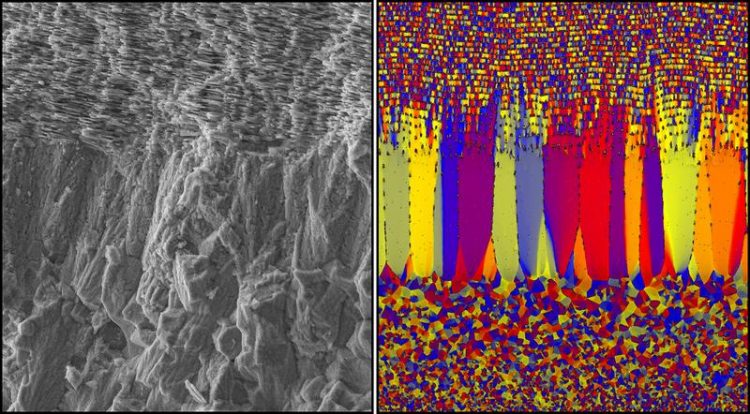Crystal growth kinetics and its link to evolution. New findings about biomineralization in molluscan shells

Left - The ultrastructure of the shell Nautilus pompilius, Right – Simulated ultrastructure of the shell on the left. © Igor Zlotnikov, Tamás Pusztai, László Gránásy
Molluscan shells consist of a variety of complex mineral-organic composite ultrastructures. Surprisingly, in some cases, shells from distantly related species contain similar morphological motifs on many different length scales, from the nano- to the micro-scale.
During the last few decades, significant progress has been made in understanding the key biochemical mechanisms responsible for biogenic mineral formation.
However, little is known on how the organisms control the form of the individual mineral building blocks comprising the different shell architectures and consequently, determine the morphology of these species-specific mineral-organic assemblies.
The Zlotnikov research group in collaboration with scientists from the Wigner Research Centre for Physics in Budapest, Hungary now developed a comprehensive experimental and theoretical framework to analytically describe the process of ultrastructural morphogenesis of molluscan shells.
Mainly, they demonstrated that the formation of these highly biomineralized tissues is guided by the organisms by regulating the chemical and physical boundary conditions that control the growth kinetics of the mineral phase.
By showing a direct link between physics of materials and the process of biomineralized tissue morphogenesis, the team sheds a new light on the evolutionary aspect of the fabrication of biological materials.
Dr. Igor Zlotnikov
Tel: +49 351 463-43090
Email: igor.zlotnikov@tu-dresden.de
Webpage: www.tu-dresden.de/bcube
Crystal growth kinetics as an architectural constraint on the evolution of molluscan shells. Vanessa Schoeppler, Robert Lemanis, Elke Reich, Tamás Pusztai, László Gránásy, and Igor Zlotnikov. PNAS. 2019.
www.pnas.org/cgi/doi/10.1073/pnas.1907229116
Media Contact
More Information:
http://www.tu-dresden.deAll latest news from the category: Life Sciences and Chemistry
Articles and reports from the Life Sciences and chemistry area deal with applied and basic research into modern biology, chemistry and human medicine.
Valuable information can be found on a range of life sciences fields including bacteriology, biochemistry, bionics, bioinformatics, biophysics, biotechnology, genetics, geobotany, human biology, marine biology, microbiology, molecular biology, cellular biology, zoology, bioinorganic chemistry, microchemistry and environmental chemistry.
Newest articles

Properties of new materials for microchips
… can now be measured well. Reseachers of Delft University of Technology demonstrated measuring performance properties of ultrathin silicon membranes. Making ever smaller and more powerful chips requires new ultrathin…

Floating solar’s potential
… to support sustainable development by addressing climate, water, and energy goals holistically. A new study published this week in Nature Energy raises the potential for floating solar photovoltaics (FPV)…

Skyrmions move at record speeds
… a step towards the computing of the future. An international research team led by scientists from the CNRS1 has discovered that the magnetic nanobubbles2 known as skyrmions can be…





















